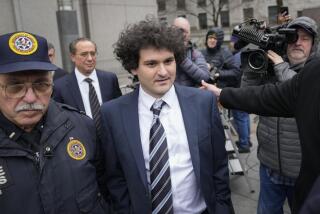VIEWPOINTS : What BankAmerica Can Do to Reverse Its Dangerous Course
- Share via
BankAmerica, on the heels of a shocking $640-million second-quarter loss, faces possibly the most difficult period in its 82-year history.
The loss, due largely to continuing problems with foreign, real estate, energy and farm loans at the company’s Bank of America unit, was the second largest in banking history and was unexpected, given that many analysts had thought the worst of the bank’s problems were over.
Now, BankAmerica faces a number of wrenching decisions. Should it sell assets and shrink? Should it undertake further cuts in personnel, which could save money but harm customer service? Should it raise new capital, and how? Should it change or restructure top management?
Meanwhile, the company must contend with possible takeover attempts while trying to maintain depositor confidence as observers wonder whether further losses are still ahead.
In an attempt to explore the various options facing BankAmerica, The Times invited bank consultants, investment analysts, academicians and investors to comment on what they think the bank’s management should do to turn the company around. Here are their comments:
BankAmerica, on the heels of a shocking $640-million second-quarter loss, faces possibly the most difficult period in its 82-year history.
The loss, due largely to continuing problems with foreign, real estate, energy and farm loans at the company’s Bank of America unit, was the second largest in banking history and was unexpected, given that many analysts had thought the worst of the bank’s problems were over.
Now, BankAmerica faces a number of wrenching decisions. Should it sell assets and shrink? Should it undertake further cuts in personnel, which could save money but harm customer service? Should it raise new capital, and how? Should it change or restructure top management?
Meanwhile, the company must contend with possible takeover attempts while trying to maintain depositor confidence as observers wonder whether further losses are still ahead.
In an attempt to explore the various options facing BankAmerica, The Times invited bank consultants, investment analysts, academicians and investors to comment on what they think the bank’s management should do to turn the company around. Here are their comments:
The problems of Bank of America, in our opinion, were created by poor organizational design, and to effectively reorient and re-establish the bank, that design must be changed. The process begins with modification of a structure that has evolved into a relatively inflexible and bureaucratic format that stifles creativity and entrepreneurship.
The past practice of heavily emphasizing employees’ job security and pension benefits, in essence, has had the effect of promoting staff mediocrity and “clonemanship” in management.
The bank’s structure was not challenged as long as the government directed banking’s funding sources and funding prices--and inflation covered judgmental deficiencies and weaknesses. But with the advent of deregulation and declines in inflation, Bank of America’s weaknesses became magnified.
These factors, along with the rapid changes in electronic banking techniques, communication capacities and customer attitudes, largely rendered the bank’s service delivery systems (about 1,000 full-service branches in California) outmoded, inefficient and expensive. In our opinion, the bank presently has more than 500 branches in California that it should sell, consolidate or close.
In problem cases, our first advice is to bring the bank down to what we call a base of reality. This means cutting fat, discontinuing unprofitable services, disposing of fixed and non-earning assets and reducing funding costs--all designed to bring the bank down to a more controllable and flexible base.
Unfortunately, we believe that the first approach used by Bank of America was to try to grow and “earn” its way out of its problems--primarily through buying relatively high-cost fundings and increasing income by making high-risk loans. The result was to compound the bank’s fundamental problems and make it very difficult to deal with them effectively.
In our view, the bank’s size needs to be reduced significantly to get down to a more controllable base--and to create the opportunity for organizational restructuring and the infusion of more creative and talented leadership.
There are indications that the bank is beginning to move in the right direction--but probably not quickly enough. Turning the “elephant,” changing its “diet” and smoothing its “wrinkles” are difficult, frustrating and time-consuming. From our perspective, the effort is still in the early stages--with several years of struggle ahead.
More to Read
Inside the business of entertainment
The Wide Shot brings you news, analysis and insights on everything from streaming wars to production — and what it all means for the future.
You may occasionally receive promotional content from the Los Angeles Times.








